
由SO-IL团队和FREAKS公司重新设计的梅森塔尔玻璃工厂
Site Verrier de Meisenthal by SO—IL and FREAKS
由专筑网江鹏,小R编译
位于法国摩泽尔省的Pays de Bitche因其拥有大量的森林、水和沙子,在很长一段时间内一直是玻璃制造的中心。该地区最初的玻璃生产是一种类型游牧的活动,即非定点生产模式,直到18世纪开始在固定地点定居生产,始于1711年的梅森塔尔玻璃工厂是最当地古老的玻璃工厂。在接下来的两个半世纪里,玻璃工厂规模不断扩大,还雇佣了著名的新艺术主义玻璃艺术家émile Gallé27年(1867-1894),在20世纪20年代达到该工厂生产的顶峰。但是,在第二次世界大战后,梅森塔尔的手工作坊生产模式无法与机械化的生产模式相竞争,最终在1969年,该工厂的熔炉似乎就永远关闭了。
Thanks to its abundant forests, water, and sand, the Pays de Bitche, in the Moselle département of France, has long been a center for glassmaking. Initially a nomadic activity, glass production in the region began to settle at fixed sites in the 18th century, and the Meisenthal glassworks, which began operating in 1711, is among the oldest. Continually expanded over the following two and a half centuries, the plant, which employed the celebrated Art Nouveau glass artist émile Gallé for 27 years (1867–94), reached the peak of its production in the 1920s. But, after World War II, Meisenthal’s artisanal methods were unable to compete with mechanized glass production, and its furnaces shut down, seemingly for good, in 1969.
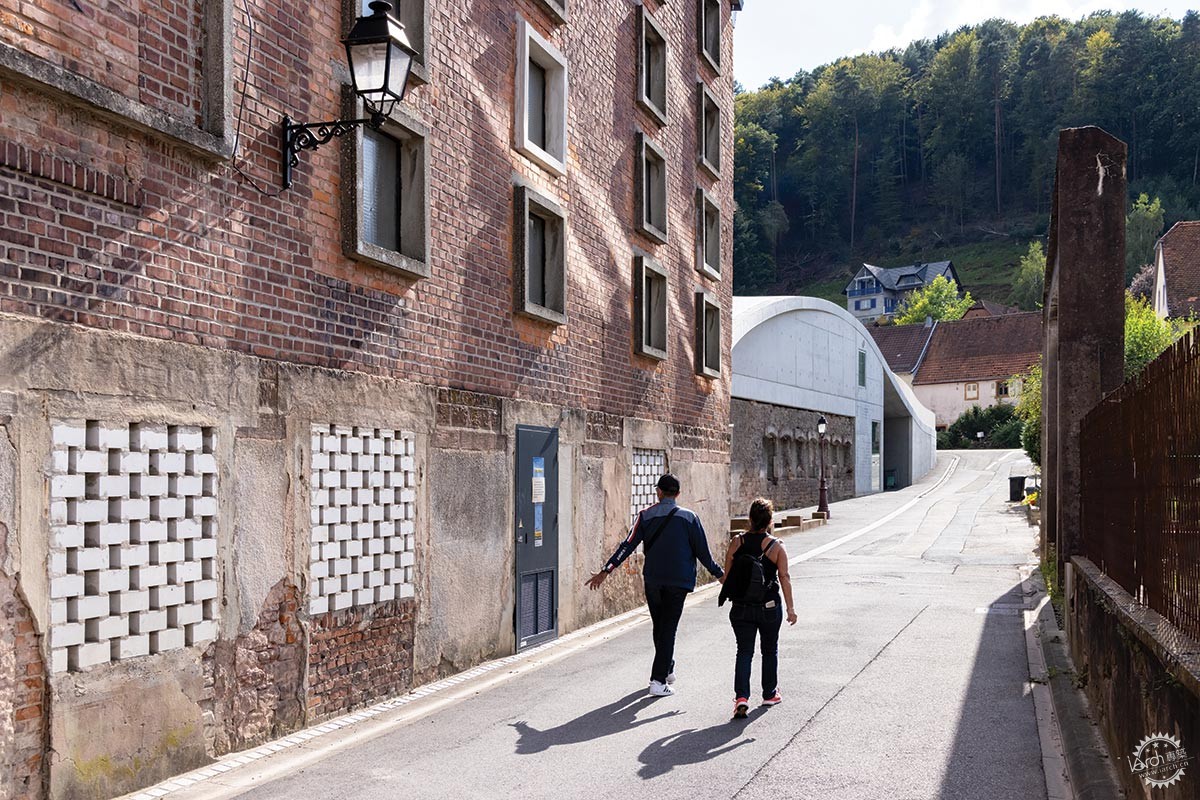
▲ 重新设计的玻璃工厂位于一个田园般的、资源丰富的环境中,可以从市中心的街道进入
The reimagined glassworks (top) lies within a bucolic, resource-rich setting and is accessed from the street (above) at the center of town.
该工厂坐落于一个拥有650户居民的村庄的中心,这个占地2.5英亩的建筑群并没有闲置太久。艺术家们开始住在里面,在1979年,当地专家在玻璃厂前行政楼里面开设了一个玻璃制造博物馆,这个行政楼的地基可以追溯到该遗址的起源,包含了第一个熔炉的遗迹。20世纪80年代初,面积3.5万平方英尺的玻璃棚开始用于艺术展览和摇滚音乐会。Halle Verrière是迄今为止最大的玻璃生产车间,建于20世纪,1992年,随着国际艺术中心(International Center d’Art Verrier,简称CIAV)的成立,该遗址复兴的最后一个要素出现了。该中心与艺术学生和国际设计师合作,同时延续该地区的传统技术。该中心因重新恢复Noël-Christmas装饰的传统而闻名,这个玻璃装饰是邻近的戈埃特藏布吕(Goetzenbruck )玻璃制品厂的特产,就像梅森塔尔玻璃工厂一样,该玻璃制品厂于1969年停止生产。
Located at the heart of a village of 650 souls, the 2.5-acre complex did not remain empty for long. Artists began to squat in it, and, in 1979, local experts opened a museum of glassmaking in the former administration building (whose foundations date back to the site’s origins and contain the remains of the first furnace). In the early 1980s, the 35,000-square-foot Halle Verrière—by far the largest of the workshops, built in the 20th century—began to be used for art expositions and rock concerts, while the final ingredient in the site’s renaissance came in 1992 with the creation of the Centre International d’Art Verrier (International Center for Fine Glassmaking, or CIAV), which works with art students and international designers to perpetuate the region’s ancestral know-how. The CIAV has since become famous for resurrecting the tradition of boules de Noël—Christmas ornaments—that were a specialty of the neighboring Goetzenbruck glassworks, which, like Meisenthal, had ceased production in 1969.
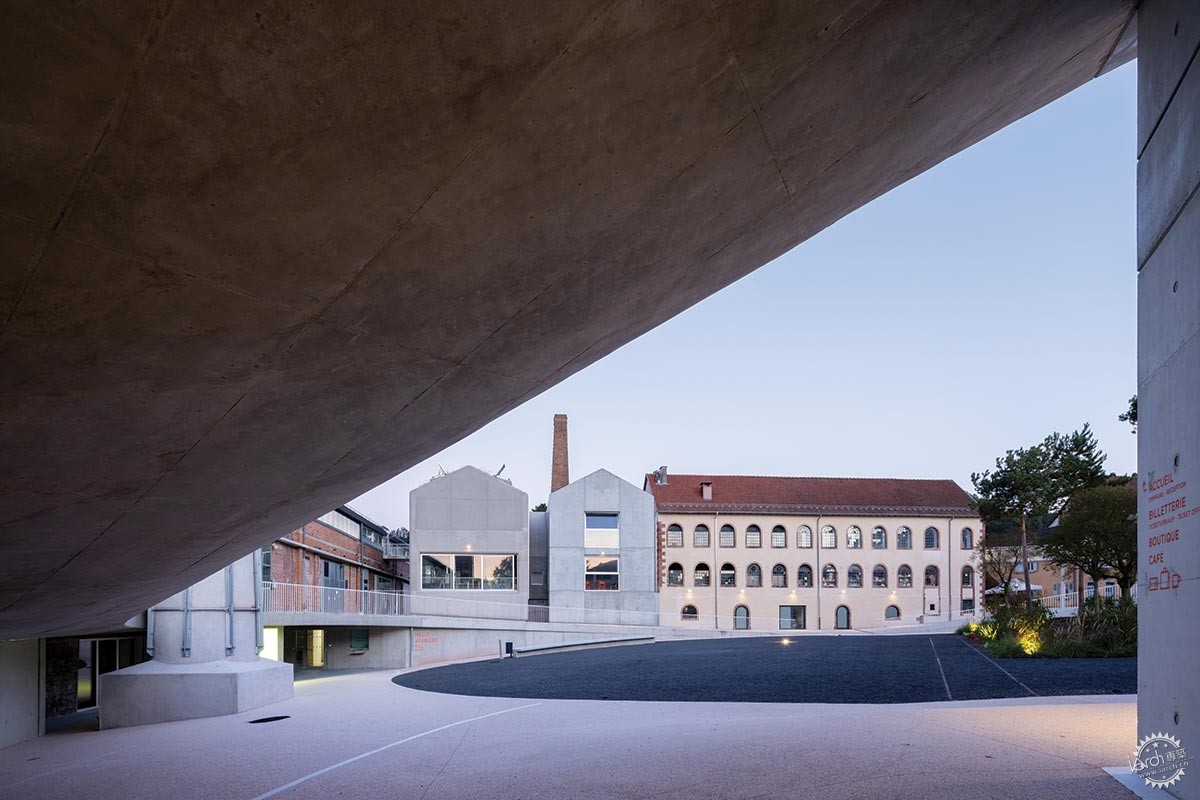
▲ 有顶棚的入口展示了庭院、玻璃棚、CIAV
The canopied entry reveals the courtyard, Halle Verrière, and CIAV
到本世纪10年代初,被改造后的梅森塔尔玻璃厂每年接待7万名游客。CIAV的领导Yann Grienenberger解释道:“我们已经证明了我们拥有观众,现在我们需要一个合适的环境和设施来欢迎他们。”。在2014年,当地政府,该地块的所有权者同意了一项价值1360万美元的重建计划,并组织了一次国际方案征集活动。该任务书包括对现有建筑的改造,为玻璃厂增建一座礼堂,为CIAV新建一座熔炉,以及为三个机构建造一座新的售票大厅或是咖啡馆。主办方希望参赛者能给一个零散的场地带来一种整体感。Grienenberger继续说道:“在收到的184份申请中,我们选择了三份,来自柏林LIN团队的“A safe pair of hands”,来自比利时Hebbelinck and de Wit与总部位于南希的工作室Studiolada联合体的“A more local team ”,以及来自总部位于纽约的SO-IL与法国FREAKS合作的“The joker entry”,“The joker entry”中标。”
By the early 2010s, the repurposed Meisenthal plant was receiving 70,000 visitors a year. “We’d proved we had the audience; now we needed a proper setting and facilities to welcome them,” explains Yann Grienenberger, CIAV’s director. In 2014, the local authority, owner of the site, agreed to a $13.6 million redevelopment plan, and an international call for proposals was organized. The brief included the renovation of the existing buildings, the addition of a black-box auditorium to the Halle Verrière, and the construction of new furnaces for the CIAV as well as of a new ticket hall/café for all three institutions. Entrants were expected to bring a sense of unity to a disparate site. “Out of the 184 submissions received, we chose three,” continues Grienenberger. “A safe pair of hands from Berlin [LIN], a more local team [the Belgians Hebbelinck and de Wit, in partnership with Nancy-based office Studiolada], and the joker entry [New York–based SO—IL, who teamed up with French practice FREAKS]. The joker won.”
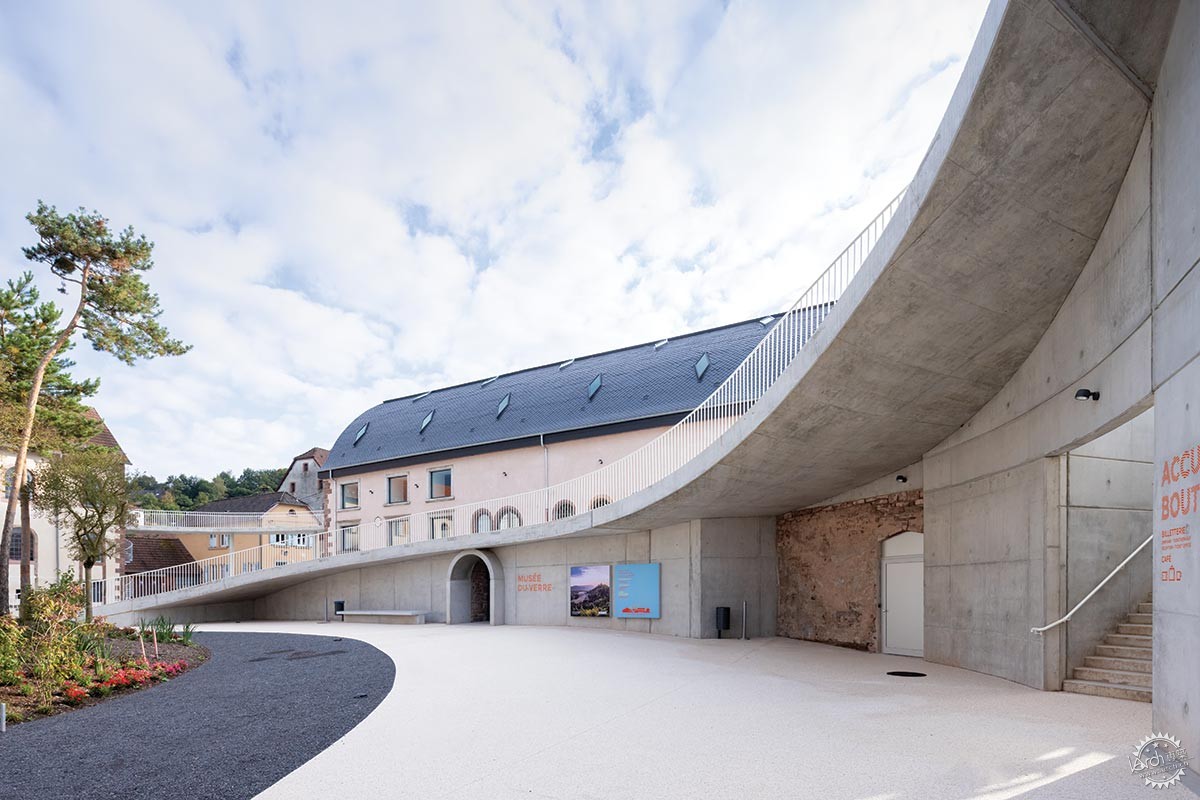
▲ 玻璃博物馆
plus the glass museum
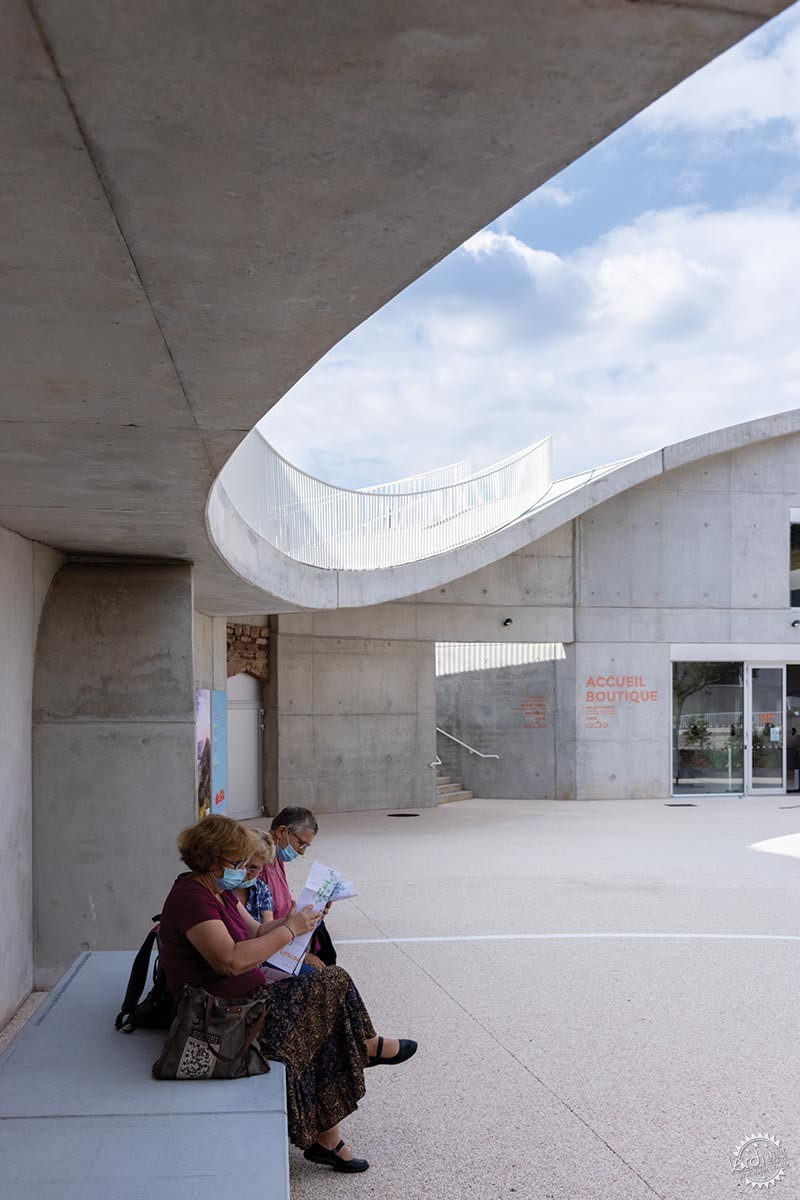
▲ 售票处
ticket office
SO-IL的创始合伙人Florian Idenburg说:“我认为,他们选择我们是因为我们的方案并没有真正的去做一个建筑,我们的方案保留了大部分现有建筑的结构。”获胜的设计非常简单,方案力图将三个机构统一在一个波浪状的混凝土中,其中也包括街道上的售票大厅,由于倾斜的地形,三个机构的入口都处在不同的高度。抵抗住用玻璃建造玻璃工厂的诱惑,SO-IL和FREAKS设计团队仍然试图通过波浪状混凝土作为“熔融土地”的象征这一概念来代表材料的一面。Idenburg解释道,这是对玻璃的隐喻,由固体变成液体,然后再变固体。SO-IL和FREAKS设计团队还试图为这三个功能实体创造一条连贯的游览路线,将三个实体布置于一个中央庭院周围,首先人们到达售票大厅(这里也有礼品店和咖啡馆),随后穿过地下室进入博物馆,在那里人们会看到第一座熔炉的遗迹,并观看一段介绍影片,然后乘电梯进入上层的展厅;随后经过行人天桥到达CIAV,在那里你可以参观玻璃雕刻车间,并从上层的内部窗户安全地观看新炉窑的玻璃制品制作过程,最后,如果那天有艺术展览的话,人们可以下到庭院进入原玻璃工厂。
“I think they chose us because we didn’t really do a building,” says Florian Idenburg, founding partner, with Jing Liu, of SO – IL. “Ours was also the project that preserved most of the existing fabric.” Seductively simple, the winning design aimed to unite the three institutions—whose entrances are all at different heights because of the sloping terrain—in an undulating wave of concrete that also includes the ticket hall on the street. Resisting the temptation to build a glassworks in glass, SO – IL and FREAKS sought nonetheless to represent the material through the idea of the concrete wave as symbolic “of molten earth. We felt it was allegorical for glass: something that is solid and becomes fluid and then hardens again,” explains Idenburg. They also aimed to create a coherent visitors’ circuit for the three entities, which are located around a central courtyard: first you arrive in the ticket hall (which also houses the gift shop and café); from there you pass into the museum via its basement, where you see the remains of the first furnace and watch an introductory film, before taking the elevator to the upper-floor galleries; a footbridge then leads you over to the CIAV, where you tour the glass-engraving workshops and watch, from the safety of an upper-floor internal window, the making of glass objects in the new furnace buildings; and, finally, you descend to the courtyard and can enter the Halle Verrière if there is an art exhibition on display that day.
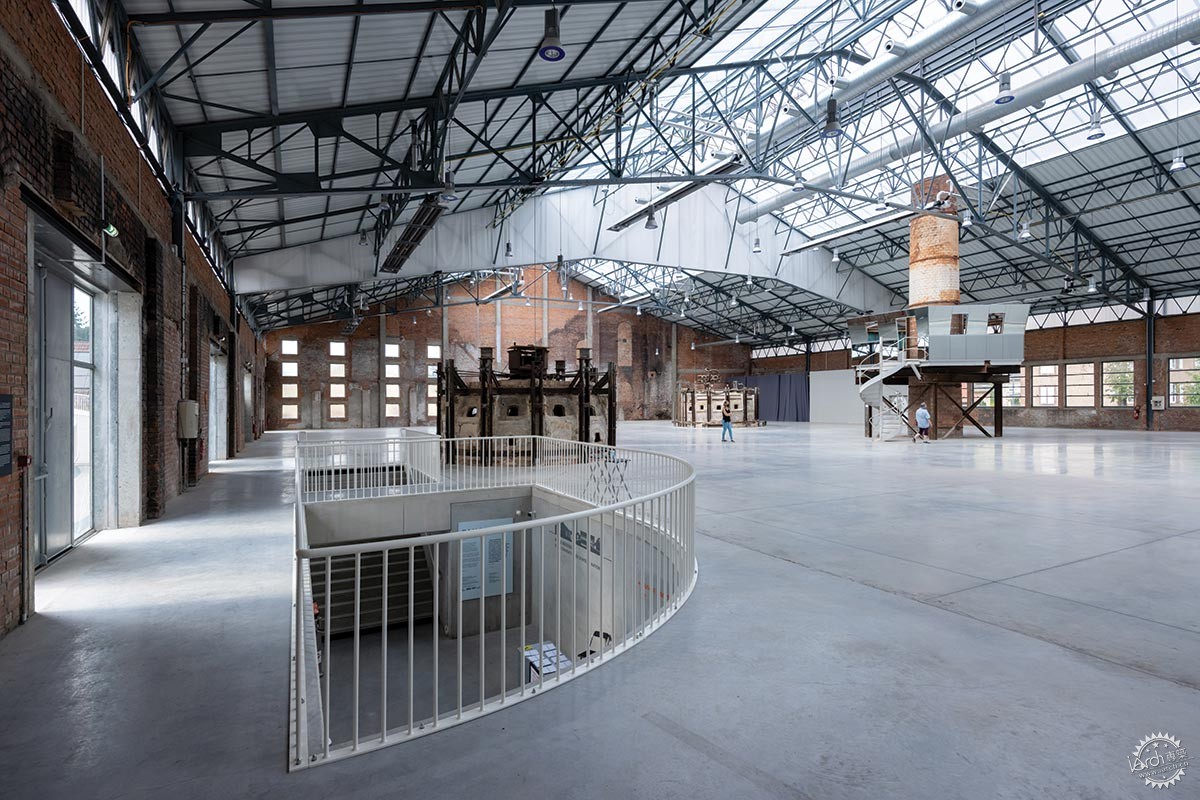
▲ 综合艺术场地包括Halle Verrière,它是由玻璃制造设施改造而成的展览和活动空间
The consolidated arts site comprises the Halle Verrière, a former glassmaking facility turned exhibition and event space
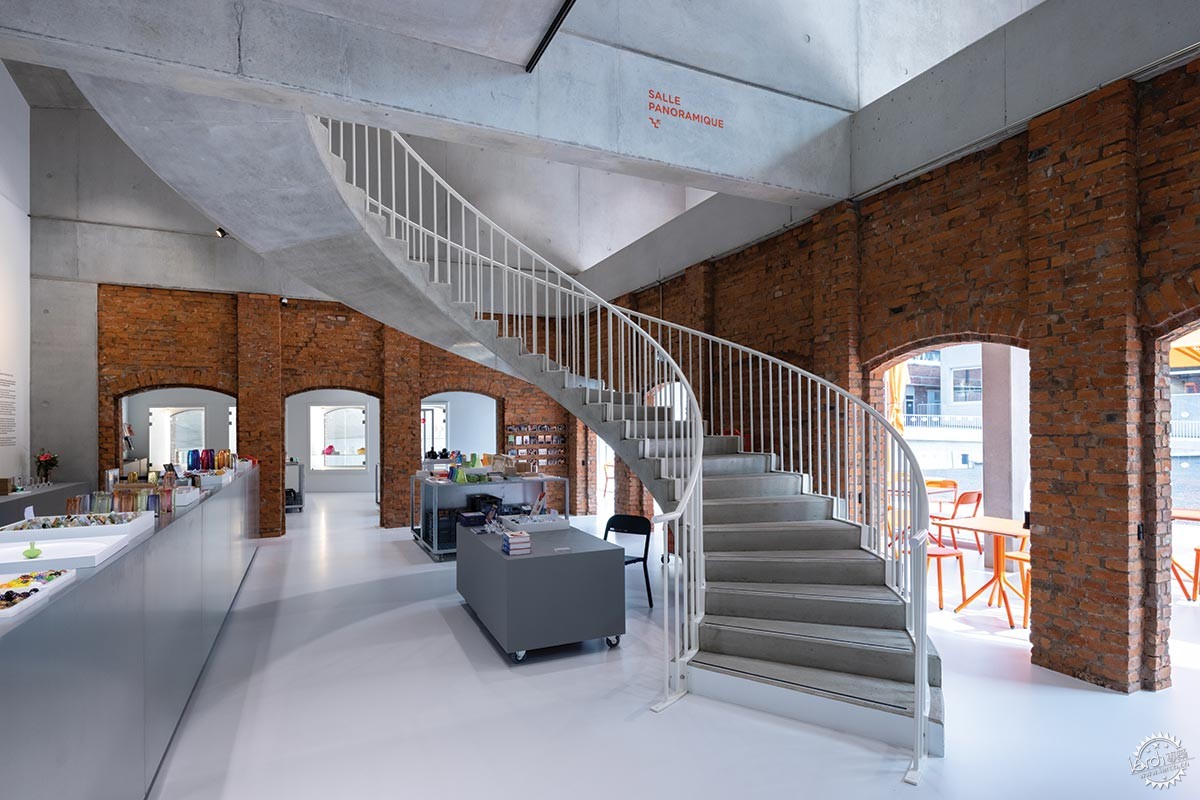
▲ 一个混合售票处/礼品店/咖啡馆内结构
a hybrid ticket office/ gift shop/café structure
在团队的参赛渲染图中,这种概念显得极为强烈,特别是从空中看,但细节却很模糊,这无疑在某种程度上解释图片上的展示与现实地形之间的差异性。混凝土承包商显然觉得建筑师的图纸太复杂了,工作做得太马虎,这也无济于事。问题从入口处就开始了,入口处有一个很深的混凝土顶棚,它从玻璃棚的一楼和售票大厅的上层之间跳跃,由此产生的不平衡感显然不招人喜欢。然后,从庭院望去,全混凝土拱顶的售票大厅笨拙得令人苦恼,它的斜坡太陡,对行人来说,这意味着起伏的线路要被栏杆打断,考虑到它所提供的非常有限的表面积,入口建筑的上层是否有必要,这一点令人好奇。
In the team’s competition renderings, the concept appears strong, especially from the air, but the details are very vague—which no doubt goes some way to explaining the disparity between the images’ rhetorical seductiveness and the reality on the terrain. Neither does it help that the concrete contractor, who apparently found the architects’ drawings too complicated to read, did such a sloppy job. The problems begin right at the entrance, which comprises a deep concrete canopy that is forced to make the jump between the ground floor of the Halle Verrière and the upper floor of the ticket hall: the resulting lopsided tunnel is distinctly uninviting. Then, when viewed from the courtyard, the all-concrete humpbacked ticket hall is distressingly ungainly, its slopes too steep for pedestrians, meaning the undulating circuit is interrupted by railings. (Given the very limited surface area it provides, was the entrance building’s upper floor even necessary, one wonders.)
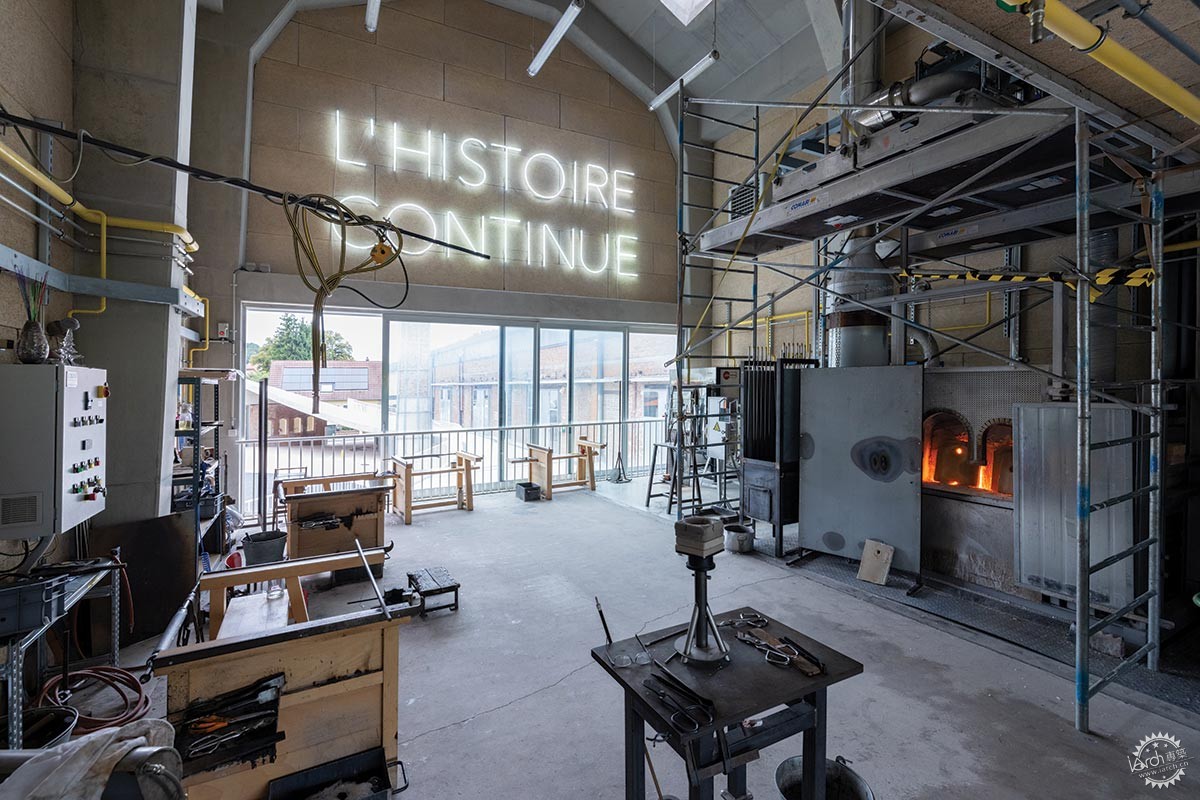
▲ 一个新的熔炉建筑
a new furnace building
方案尽管有这些保留意见,但还是有很多可取之处。玻璃工厂的改造是理智和实用的,有一个新的低层公共入口,宽敞的更衣室,和一个大型酒吧,为主厅和黑盒子礼堂提供服务。而后者因其声学效果和可适应性而受到了工作人员和来访艺术家的一致好评,其中包括在两侧开放舞台的可能性,这是建筑师提出的一个想法——允许它在主空间用于3000人的大型音乐会。博物馆画廊由设计师单位展出,完成得同样朴实无华,售票厅的一楼(包括一座砖结构的废墟)和两座新的熔炉建筑,一座是20世纪20年代的混凝土框架结构,另一座是现场浇筑的新炉。如果建筑师在简单波浪的象征意义上做得更轻盈一点,这个项目将获得巨大的影响力。
Despite these reservations, there is much to like. The transformation of the Halle Verrière is sober and practical, with a new lower-level public entrance, generous dressing rooms, and a large bar catering both to the main hall and the black-box auditorium. The latter has been praised by both staff and visiting artists alike for its acoustics and adaptability (which includes the possibility of opening the stage on both sides—an idea put forward by the architects—allowing it to be used for large-scale concerts of 3,000 in the main space). The museum galleries, with displays by Designers Unit, are just as unpretentiously accomplished, as are the ground floor of the ticket hall (which incorporates the ruins of a brick structure) and the two new furnace buildings—one a recladding of a 1920s concrete frame, the other its doppelganger, poured on-site. If the architects had gone a little lighter on the facile wave symbolism, this project would have gained enormously in potency.
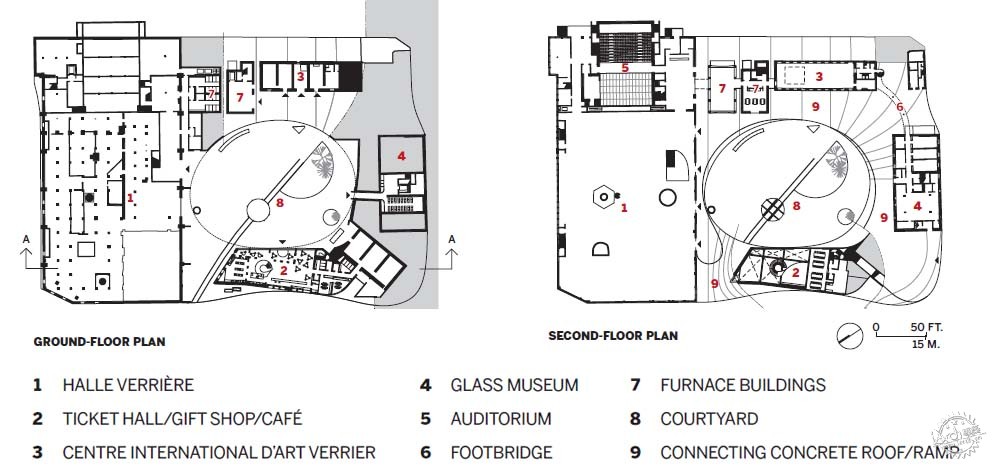

|
|
